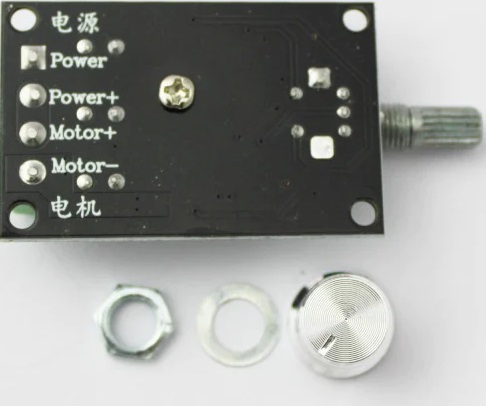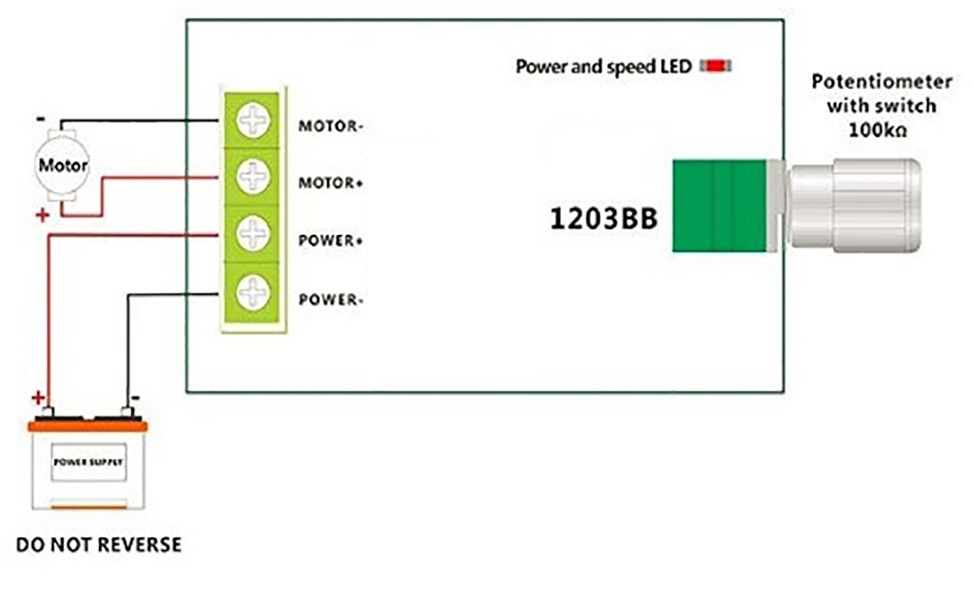AED 22.05
Description
This motor speed controller is a versatile and useful device for controlling the speed and direction of DC motors or other DC loads. The adjustable duty cycle and potentiometer speed control make it easy to fine-tune the motor's performance. The maximum output power of 80W and maximum continuous output current of 3A make it suitable for a variety of applications.
Package Includes:
- 1 x Motor Driver PWM Speed Switching Controller DC 6V 12V 24V 28v 3A
Features:
- Allows for smooth and precise control of DC motor speed and direction using PWM signals
- Can provide a continuous current of up to 3A to the motor or other DC load
- Supports input voltage ranging from 6V to 28V DC, with a maximum output power of 80W
- The duty cycle is adjustable from 5% to 100%, allowing for fine-grained control of motor speed
- The direction of the motor can be changed with a simple control input
- Compact and easy-to-use module, with clear wiring diagrams and instructions
- Can be used in a variety of applications, including robotics, automation, and DIY electronics projects.
Description:
The Motor Driver PWM Speed Switching Controller is a versatile device that allows you to control the speed and direction of a DC motor using Pulse-Width-Modulated (PWM) DC voltage with a duty cycle that is fully adjustable from 5% to 100%. This motor speed controller can provide a continuous current of up to 3A to your DC motor or other DC load, with a maximum output power of 80W. The input supply voltage for this motor driver module is between 6V-28V DC, making it compatible with a wide range of power sources. The motor driver comes with a wiring diagram that makes it easy to connect your DC motor or other DC load to the motor terminals. Additionally, it is recommended to add an appropriately rated fuse in line with the positive supply in order to protect the circuit from any possible short circuits.
Principle of Work:
The Motor Driver's PWM Speed Switching Controller works by using Pulse-Width-Modulated (PWM) DC voltage to control the speed and direction of a DC motor or other DC load. The module receives an input voltage from a power source (6V-28V DC), which is then used to power the motor or load. The controller generates a PWM signal with a duty cycle that is adjustable from 5% to 100%. The duty cycle determines the amount of time the signal is "on" versus "off" over a given period, and this controls the average voltage that is applied to the motor or load. By varying the duty cycle of the PWM signal, the motor speed can be adjusted smoothly and accurately. The module also has a direction control input, which allows you to change the direction of the motor. When this input is high, the motor will rotate in one direction, and when it is low, the motor will rotate in the opposite direction.
Pinout of the Module:

- Motor+: Motor Positive Terminal
- Motor-: Motor Negative terminal
- Power+: DC 6V – 28V
- Power: Gnd
Applications:
- Motor speed control for robotics and automation projects
- Control of fans and pumps in DC systems
- Control of conveyor belts and other industrial machinery
- Control of RC vehicles and drones
- Control of power tools such as drills and saws
- Control of model trains and other hobby projects
- Control of lighting systems and other home appliances.
Circuit:
Steps to control a 12V motor using the Motor Driver PWM Speed Switching Controller module with a 12V battery:
- Connect the positive terminal of the 12V battery to the Power + input of the Motor Driver PWM Speed Switching Controller module.
- Connect the negative terminal of the battery to the Power - input of the module.
- Connect the positive lead of the motor to the OUT+ terminal of the module.
- Connect the negative lead of the motor to the OUT- terminal of the module.
- Turn on the battery power and adjust the potentiometer to vary the duty cycle of the PWM signal and control the speed of the motor.

Library:
No Library Needed
Code:
No code needed
Technical Details:
- Voltage range: DC6V – 28V
- Current range: Within 3A
- Switch function: None
- Speed range: 0-100%
- Dimension: 65 x 30 x 15mm
- Weight: 25 g
Resources:
Comparisons:
Using the Motor Driver PWM Speed Switching Controller module and using an Arduino with a motor driver to control a DC motor both have their advantages and disadvantages.
Advantages of using the Motor Driver PWM Speed Switching Controller module:
- The module is a standalone device and does not require programming or a microcontroller to operate.
- The module is compact and easy to integrate into a circuit.
- The module has a wide input voltage range of 6V-28V, which allows it to be used with a variety of motors and power sources.
- The module is capable of providing up to 3A continuous output current, which is suitable for many small to medium-sized motors.
- The module is relatively inexpensive compared to an Arduino and motor driver combination.
Advantages of using an Arduino with a motor driver to control a DC motor:
- An Arduino with a motor driver provides more flexibility and control over the motor operation. The motor can be controlled using code and programmed to respond to various inputs and conditions.
- An Arduino can be used to control multiple motors or other devices simultaneously, making it suitable for more complex projects.
- An Arduino can be used to add additional sensors or features to the motor control system, such as temperature sensors, limit switches, or wireless control.
- An Arduino with a motor driver can provide higher output current and power than the Motor Driver PWM Speed Switching Controller module, making it suitable for larger motors or applications that require more power.
In the end, the choice between using the Motor Driver PWM Speed Switching Controller module and using an Arduino with a motor driver to control a DC motor depends on the specific needs of the project. If simplicity and cost are the primary concerns, then the module may be the better choice. If flexibility and control are important, then the Arduino with motor driver may be the better choice.